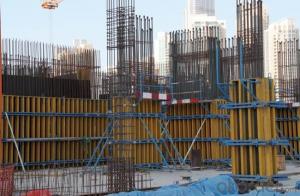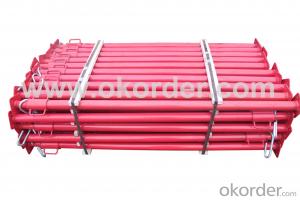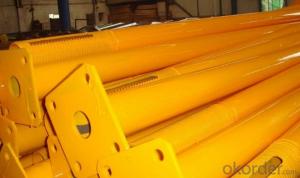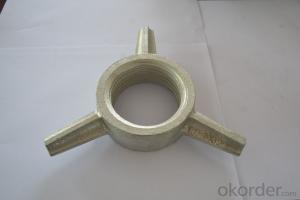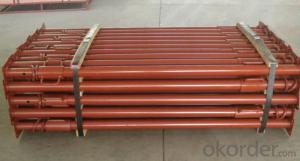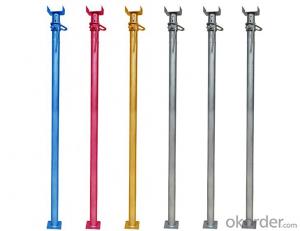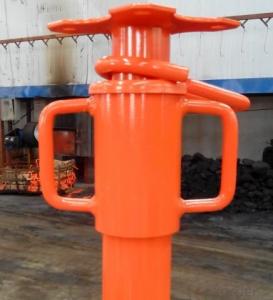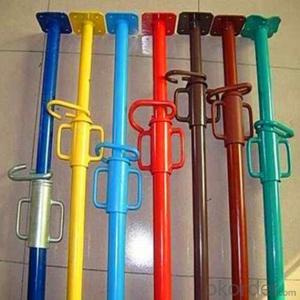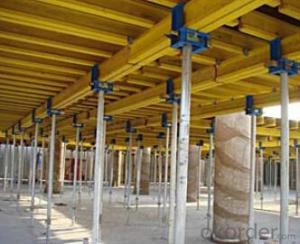Timber beam wall and column formwork
- Loading Port:
- China Main Port
- Payment Terms:
- TT OR LC
- Min Order Qty:
- -
- Supply Capability:
- -
OKorder Service Pledge
OKorder Financial Service
You Might Also Like
Timber beam wall formwork
Timber beam wall formwork is used for the concrete pouring of wall. The application oflarge areas formwork has greatly increased
the construction efficiency and reduced the cost. The system is convenient for construction and it is easy tocontrol the quality.
The system has two parts, formwork and pull-push props.The formwork is made of plywood, timber beam and steel waling. Pull-push props can be designed according to the project or simply select the standard props.Tie-yoke and tie rod are used to reinforce
the corner.


- Q:Are steel props easy to install and dismantle?
- Generally, steel props are easy to install and dismantle. They are commonly used in construction projects to support temporary structures like scaffolding or formwork. When installing them, they are positioned and their height is adjusted according to project requirements. Most steel props have an adjustable mechanism for easy height adjustment, making it convenient for different construction needs. Similarly, dismantling steel props is typically straightforward. After the temporary structure is no longer needed, the props can be easily removed by reversing the installation process. This involves lowering the props, releasing any locking mechanisms, and removing them from their positions. Moreover, steel props are often designed with lightweight materials like aluminum or steel alloy, enhancing their portability and ease of handling. This allows construction workers to install, adjust, and dismantle them with ease, saving time and effort during construction or renovation projects. However, it's important to note that the ease of installation and dismantling may vary depending on the specific design and manufacturer of the steel props. Proper training and adherence to safety guidelines are crucial to ensure correct installation and dismantling procedures are followed, minimizing potential risks or accidents.
- Q:How long can a steel prop be used before it needs to be replaced?
- The lifespan of a steel prop depends on various factors such as the quality of the prop, its usage conditions, and maintenance. However, generally speaking, steel props can be used for several years before they need to be replaced. Regular inspections and maintenance can help prolong their lifespan and ensure their safety and effectiveness.
- Q:Can steel props be used for supporting temporary walkways or ramps?
- Yes, steel props can be used for supporting temporary walkways or ramps. Steel props, also known as adjustable steel props or steel acrow props, are commonly used in construction projects to support structures and provide temporary bracing. They are designed to provide stability and load-bearing capacity, making them suitable for supporting walkways or ramps. Steel props are adjustable in height, allowing them to be set at the desired level to support the temporary structure. They come in various sizes and weight capacities, making it easy to choose the appropriate prop for the specific application. Additionally, steel props are made from strong and durable materials, ensuring their ability to withstand the weight and pressure exerted by individuals walking or using ramps. When using steel props for supporting temporary walkways or ramps, it is important to ensure proper installation and adherence to safety guidelines. The props should be securely placed and evenly distributed to provide a stable and even surface. Regular inspections and maintenance should also be conducted to ensure the props remain in good condition and continue to provide adequate support. Overall, steel props are a reliable and effective option for supporting temporary walkways or ramps, offering the necessary strength and stability required for safe usage.
- Q:Can steel props be used in temporary support of arches?
- Indeed, in the temporary support of arches, steel props find utility. Adjustable supports known as steel props are frequently employed in construction to furnish temporary support to a range of structures, arches included. Engineered to possess robustness and stability, these props are capable of withstanding substantial loads. The props can be effortlessly adjusted to the desired elevation, ensuring dependable support throughout the arch's construction or repair process. Moreover, steel props exhibit durability, enabling them to endure the forces exerted by the arch's weight and thereby guarantee the structure's stability and safety during the temporary support phase.
- Q:How do steel props compare to trench jacks in terms of performance?
- Steel props and trench jacks are both commonly used for supporting trenches and excavations, but they have some key differences in terms of performance. Steel props, also known as adjustable steel props or acrow props, are telescopic steel tubes with adjustable lengths. They are designed to provide vertical support to trenches and can be easily adjusted to different heights. Steel props are known for their versatility, as they can be used in various construction applications and can support heavy loads. They are also relatively lightweight and easy to handle. On the other hand, trench jacks are also used for supporting trenches but have a different design and functionality. Trench jacks consist of a series of steel bars connected by pins, forming a framework that can be adjusted to fit the width of the trench. They are typically used for smaller, narrower trenches and may have a limited load-bearing capacity compared to steel props. Trench jacks are generally more suitable for lightweight or temporary support requirements. In terms of performance, steel props offer more flexibility and adaptability due to their adjustable lengths. This allows for easy customization to suit different trench depths and requirements. Steel props also have a higher load-bearing capacity, making them suitable for supporting heavier loads or larger excavations. Additionally, their lightweight nature makes them easier to transport and install. Trench jacks, on the other hand, may be more suitable for smaller trenches or temporary support needs. They are generally quicker to assemble, thanks to their simple design, and can be easily adjusted to fit the trench width. However, trench jacks may not be as versatile or able to handle heavy loads compared to steel props. Ultimately, the choice between steel props and trench jacks depends on the specific requirements of the project. Factors such as trench size, load-bearing capacity, and the need for adjustability will determine which option is more suitable.
- Q:Can steel props be used in both residential and commercial construction?
- Yes, steel props can be used in both residential and commercial construction. Steel props are versatile and commonly used temporary support structures that can provide stability and reinforcement during various stages of construction in both residential and commercial settings.
- Q:What are the common causes of failure of steel props?
- The failure of steel props, which are temporary support structures used in construction projects, can be attributed to several common causes. These causes can be divided into three main factors: design, material, and usage. Design flaws are one of the primary contributors to steel props failure. Inadequate calculations during the design process, such as underestimating load-bearing capacity or required height, can result in structural failure. Insufficient bracing or improper placement can also lead to instability and collapse. Therefore, it is imperative to ensure a thorough design process that takes into account the specific requirements and conditions of the construction project. The quality and material of the steel props themselves also play a significant role in their failure. Substandard materials or manufacturing defects can weaken the structural integrity of the props, making them more prone to failure. If the steel used in the props is of low quality or lacks proper treatment or corrosion resistance coating, premature deterioration and subsequent failure may occur. Regular inspections and maintenance are crucial to identifying any potential material-related issues and preventing failures. Improper usage and handling of steel props can also contribute to their failure. Overloading the props beyond their rated capacity is a common cause of failure. This can happen when contractors or workers disregard the guidelines and specifications provided by the manufacturer. Additionally, mishandling during transportation, assembly, or disassembly can result in damage or misalignment of the props, compromising their structural integrity and potentially causing failure. To minimize the risk of failure, it is essential to ensure proper design, use high-quality materials, and adhere to the manufacturer's guidelines for installation and usage. Regular inspections, maintenance, and training of construction workers on proper handling and usage techniques are also crucial to prevent the failure of steel props.
- Q:Do steel props require any special inspections or certifications?
- Special inspections and certifications are typically necessary for steel props. Steel props, also known as adjustable steel props or acrow props, are commonly used in construction to provide temporary support or to support temporary structures during construction or renovation projects. These props are designed to withstand heavy loads and must meet specific safety standards to ensure their structural integrity. In most jurisdictions, qualified professionals must regularly inspect steel props to ensure they are in good working condition and meet safety requirements. These inspections may involve visual checks for damage or wear, as well as load testing to determine the props' load-carrying capacity. Furthermore, steel props may need certification from regulatory bodies or industry standards organizations. These certifications guarantee that the props have undergone thorough testing and meet specific safety criteria. The certification process typically includes rigorous evaluations of the props' design, materials, and performance. Contractors, construction companies, and individuals using steel props must comply with these inspection and certification requirements. Regular inspections and proper certification are crucial for worker safety, accident prevention, and the structural stability of temporary structures or support systems. Moreover, it is advisable to adhere to the manufacturer's guidelines and instructions for the appropriate use, maintenance, and storage of steel props. This helps extend their lifespan, maintain their performance, and minimize the risk of failure or accidents. In conclusion, while steel props offer a dependable and versatile solution for temporary support in construction projects, they necessitate special inspections and certifications to ensure safety and compliance with regulatory standards.
- Q:Are steel props resistant to extreme weather conditions?
- Generally, steel props exhibit resistance to extreme weather conditions. Steel possesses renowned strength and durability, rendering it highly impervious to diverse weather elements. It can endure forceful winds, copious rain, snowfall, and extreme temperatures without succumbing to harm or degradation. Moreover, steel props frequently receive protective coatings like galvanization or powder coating, amplifying their ability to withstand rust and corrosion emanating from inclement weather. Consequently, steel props prove themselves as a dependable option for construction undertakings situated in regions susceptible to severe weather.
- Q:Can steel props be used for temporary support during bridge construction?
- Temporary support during bridge construction can be achieved with the utilization of steel props. These props, also referred to as adjustable steel props, acrow props, or shoring props, are extensively employed in the construction industry for the purpose of providing temporary support to various structures, including bridges. Steel props possess exceptional strength, durability, and adjustability, rendering them ideal for supporting heavy loads and guaranteeing the stability of the bridge throughout the construction phase. They are specifically designed to withstand substantial vertical loads and can be effortlessly adjusted to achieve the required height, thereby offering flexibility in bridge construction where differing heights may be necessary at distinct stages. The utilization of steel props for temporary support during bridge construction presents several advantages. Firstly, their adjustable nature permits precise support, thereby ensuring the bridge remains level and properly aligned. Secondly, steel props can be swiftly and easily installed, resulting in time and labor savings. Additionally, their reusability makes them a cost-effective solution for temporary support requirements. However, it is crucial to ensure that steel props are appropriately designed and installed by experienced professionals in order to guarantee their safety and effectiveness. Sufficient calculations and engineering considerations should be made to determine the suitable prop size, spacing, and load capacity based on the specific demands of the bridge construction project. In conclusion, steel props are indeed a viable option for temporary support during bridge construction. Their strength, adjustability, and cost-effectiveness make them well-suited for providing temporary support and ensuring the stability of the bridge throughout the construction process.
1. Manufacturer Overview |
|
|---|---|
| Location | |
| Year Established | |
| Annual Output Value | |
| Main Markets | |
| Company Certifications | |
2. Manufacturer Certificates |
|
|---|---|
| a) Certification Name | |
| Range | |
| Reference | |
| Validity Period | |
3. Manufacturer Capability |
|
|---|---|
| a)Trade Capacity | |
| Nearest Port | |
| Export Percentage | |
| No.of Employees in Trade Department | |
| Language Spoken: | |
| b)Factory Information | |
| Factory Size: | |
| No. of Production Lines | |
| Contract Manufacturing | |
| Product Price Range | |
Send your message to us
Timber beam wall and column formwork
- Loading Port:
- China Main Port
- Payment Terms:
- TT OR LC
- Min Order Qty:
- -
- Supply Capability:
- -
OKorder Service Pledge
OKorder Financial Service
Similar products
New products
Hot products
Hot Searches
Related keywords
